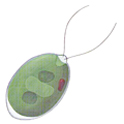 Along with Andrew Morgan, Nick Colegrave and Peter Keightley I recently published the mutation rate of the model alga Chlamydomonas reinhardtii. My study came out in the December issue of the Genetics Society of America's journal, AKA Genetics.
Along with Andrew Morgan, Nick Colegrave and Peter Keightley I recently published the mutation rate of the model alga Chlamydomonas reinhardtii. My study came out in the December issue of the Genetics Society of America's journal, AKA Genetics.
Here is the simple fact that justifies the study of mutation -- mutation is the raw source of variation that is selected for or against during evolution. It's hard to believe that the entire diversity of life and its underlying genetic complexity has come from selecting the good mutations from the rest. This filtering process defines evolution by natural selection and these variations allow us to draw the relationships amongst species, to explain the existence of genetic disease and to understand why we bother with sex. There is so much in biology that relies on mutation that it is hard to believe how little we actually know about it. I think this stems from a simple fact, mutation is rare. Despite that the diversity of species, and genes has been derived from these random mutations, evidence suggests that they occur at rates between 1 and 10 in billion per site in the genome, per generation. It's hard to believe that a bacteria with a genome of maybe 10 million bases (your ACGT's) and a human with over 3 billion bases could have arrived where they are through such a process of trial and error, or more accurately error and trial.
In our study we estimate the mutation rate directly using two main components. The first component allows rare mutations to build-up over time without the action of selection, removing the bad ones and retaining the good ones. This type of experiments is called a 'mutation accumulation' experiment and works like this: every few generations we randomly select a single individual to start the next generation. This individual will potentially carry some new mutations, which are passed on to the next generation, regardless of whether they are good or bad. When we repeat this process hundreds of time what we have is a single individual, whose ancestral line goes back to the beginning of the experiment and carries all of the mutations that happened to them along the way. The second component of the experiment is identifying the mutations. This would have been near impossible a few years ago but now, with new DNA sequencing technology, we can sequence the genomes of our mutated lines and actually count the mutations. Its this capability that is opening up the study of rare spontaneous mutations. So here is what we found.
Mutations in the green algae Chlamydomonas reinhardtii occur in 3 of every 10 billion positions in the genome per generation (μ = 3.3E-10). To put that in context, it is almost 30 times lower than what we find in humans and if we consider the size of the genomes humans pass on about 1200 mutations for every mutation passed on by C. reinhardtii's. So is there so much variation in the mutation rate? This is a big open question. Evolutionary biologists agree, that in general natural selection is drives the mutation rate down. This is simply because, despite that we need mutations to evolve, the vast majority of them are bad. The lower bound of the mutation rate might be a result of simple physical constraints so that improving the machinery for fixing and repairing DNA is to costly or difficult to get any better. Alternatively, the boundary might be the point at which the improvements are so small that natural selection doesn't discern between the variants. An important detail of this hypothesis is that the ability of selection to operate depends not just on the strength of selection but the strength of the interfering force known as genetic drift. Drift results from random sampling error in the frequencies of variants from year to year - and in small populations sampling error is more severe. As a result in small populations, as humans have been historically, the mutation rate has not evolved to the low levels seen in species with large population sizes, such as C. reinhardtii. Whether this hypothesis is true remains to be seen. There are currently so few species with known mutation rates that we can't yet test this idea thoroughly. In addition, there are other complexities to consider, such as - what is a generation in a single-celled algae? Can species with huge genomes have more mutations with no consequence and might this allow them to have higher mutation rates? Hopefully in the future we can start to get answers to these basic questions and finally start to understand this fundamental process.
